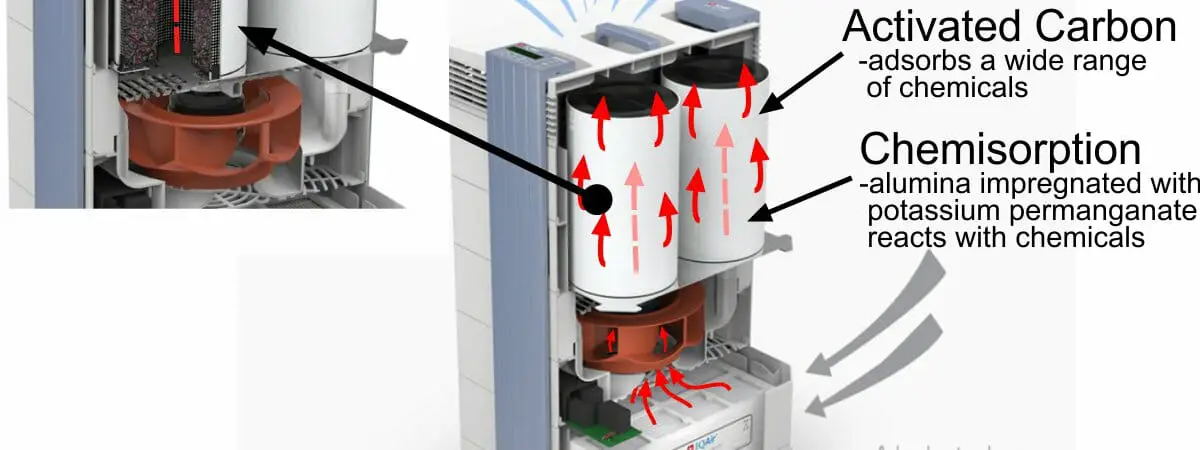We spend as much as 90% of our time indoors, either at home or at work. Volatile and semivolatile organic compounds (VOCs and SVOCs) are found in virtually all indoor air at levels that are 2-5 times those in outdoor air. Organic compounds are molecules made principally of carbon hydrogen and oxygen, they are present throughout nature. For instance, almost all of our food is made from non volatile organic compounds.
However VOCs can be made by man for manufacturing and industrial purposes, these sometimes have harmful side effects. Similarly, when organic matter is burnt it can also produce toxic chemicals, many of which are VOCs. For instance, tobacco smoke produces more than 4000 potentially harmful chemicals, of which more than 60 are potentially carcinogenic.
This also applies to forest fires, where one of the biggest threats to human health are airborne chemicals, in addition to the usual threat of airborne particles.
The best air purifier for removing volatile organic compounds is the iQAir Multigas. A close second and cheaper option is the iQAir HealthPro plus. Both have chemical removal filters with activated carbon and alumina impregnated with potassium permanganate, and ultrafine particle removal.
As semi-volatile organic compounds are not very volatile when in the gas phase so they are adsorbed/condensed onto airborne particles, dust that has settled, walls, furniture, curtains and other objects. So they exist in the indoor environment as gas, but also as a condensate on airborne particles and surfaces. One of the major ways of them getting into our body is by contaminated dust settling on the food and drink which we then ingest with the particles.
Occasionally fully volatile organic compounds are present in the indoor air. These can be from, for instance paint, glue or cosmetics. As they are so volatile they are present in the air at high concentrations, so they usually have a very pungent smell. Because of the smell, they are in many ways less dangerous as we realize that they are there, stimulating us to ventilate the home or move away from them.
Semivolatile organic compounds are more insidious as they are in very low concentration in the air so we do not smell them, so we are not really aware of their presence.
Health Concerns from VOCs and SVOCs
General Health Concerns
There are many potential health concerns as outlined in this diagram –
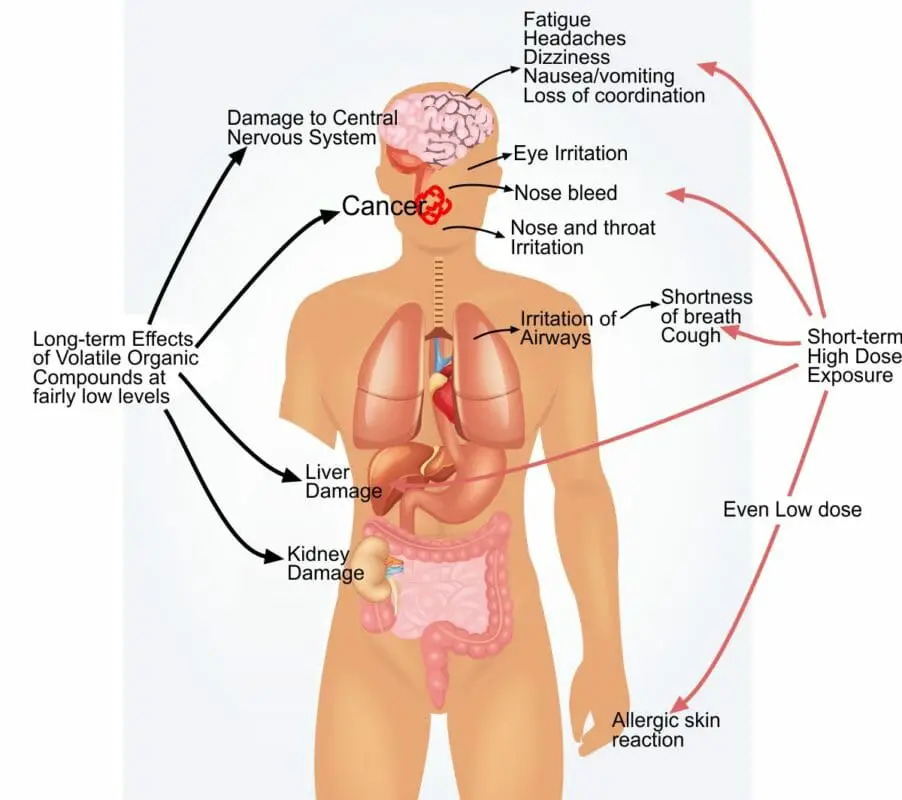
Some SVOCs are carcinogenic
The problem is that amongst the SVOCs, there are some carcinogenic chemicals. Particularly polycyclic aromatic hydrocarbons and phthalate esters.
Polycyclic aromatic hydrocarbons are formed from the incomplete combustion of organic matter, eg fires or cigarette smoke and are widespread throughout the environment.
For further details please see this article, “VOCs and Health-present in all our homes cancer is the main problem“.
Other Effects on Lungs and Thyroid Hormones
Phthalates are widely used in the building industry, they are used as plasticizers. In addition to being carcinogenic, they may have other effects as well. They can be breathed in either as a gas or more importantly, on the surface of particles that are breathed deeply into lung tissue. Here they can mimic inflammatory chemicals called prostaglandins and may cause asthma. They may also interfere with thyroid function, reducing thyroid hormone levels.
So there are very significant health concerns from VOCs and SVOCs making consideration of removing them from the air with the best possible VOC air purifier particularly important.
Air Purifiers Reduce SVOC Exposure and So Potentially Cancer Risk
An obvious way to improve air quality is to use an air cleaner, which in addition to having a true HEPA filter to remove airborne particulates, almost always also has at least a carbon filter to remove chemical air pollution. This is needed as gaseous pollutants will travel straight through a true HEPA filter as the molecules are small enough to pass through the pores in the filter.
One study simulated the effect of air purifiers and a mechanical ventilation system on the lifetime increase in cancer risk due to PAH and Phthalates (DEHP) in Beijing-
| Control/Intervention | PAH | DEHP |
|---|---|---|
| Control | 44 | 36 |
| Air purifier | 24 | 8 |
| Mechanical ventilation (eg HVAC but no return air and 0.5 air changes per hour) | 49 | 148 |
So from this study, to reduce cancer risk of SVOCs having an air purifier is by far the best strategy. Ingestion of settled dust was the most important contributor to the total incremental lifetime cancer risk. So a robotic HEPA vacuum cleaner is also necessary to remove as much settled dust from the floor as possible. Otherwise, every time we walk on the floor the settled dust is disturbed back into the air then it can settle on our food or we may breathe it in.
The vacuum cleaner needs to have a HEPA filter so that the dust, however fine, is trapped and not just ejected from the vacuum cleaner back into the air only to settle again. Having a robotic vacuum cleaner makes it practical to be almost continuously vacuuming parts of the home.
It should be noted that in the US HVAC systems often have no ability at all to remove gaseous VOCs as there is not usually any activated carbon in the system. It is possible to buy filters with carbon on them, but there is so little carbon on the filter considering the volume of air processed by the system that this will not be as good as an air purifier in one room with a larger amount of carbon in the filter.
Also, standard HVAC systems have filters that are not very good at catching particles that can damage human health. It is possible to upgrade the HVAC filter/system, and make a meaningful difference-“Make a dream “Whole Home Air Purifier” from an HVAC System?“. However, air purifiers are still better at removing particles from the air.
The Mechanism by Which Filters Remove VOCs From the Air
There are three main mechanisms by which the filters can remove chemicals from the air –
- Electrical attraction to molecules in the filter– Van der Waal’s/London forces. This is a weak interaction and is reversible so VOCs can be released from the filter.
- Reacting with the surface of the filter and bonding to the filter, eg hydrogen bonding or being oxidised by additives in the filter. This is referred to as “chemisorption” and is permanent.
- Hydrophobic bonding-segregation of water and non-polar substances, eg oil in water tends to coalesce together. Similarly, organic compounds may tend to “coalesce” with the filter away from the water vapour in the air.
The difference between adsorption and absorption is that in adsorption the chemical is bound to the surface of the filter substance whereas with absorption the chemical actually enters the filter substance itself. Filters in air purifiers work by adsorption.
There is also a fourth mechanism, which occurs when the chemical in the air reacts with a chemical in the filter and is destroyed. For instance, this occurs when formaldehyde reacts with potassium iodide in a filter and is oxidised.
Advantage of Activated Carbon Filters
The advantage of an activated carbon filter is that it will adsorb a vast array of chemicals from the air. It is neither hydrophobic or hydrophilic. Of course it is not perfect, there are some smaller chemicals which are not so well absorbed which I cover in the next section.
Activated carbon filters absorb both reactive and nonreactive VOCs. They do this to a modest extent but across a wide range of chemicals. One study showed that photo electrochemical oxidation (PECO) is the only other technology that will deal with both reactive and nonreactive VOCs. In this study, the CADR for removing both types of VOCs from the air reduced with increasing relative humidity but was approximately 10 times that of an activated carbon filter. The problem was that PECO in this study was shown to produce formaldehyde and other carbon compounds which could potentially be a health problem. Both of which could also potentially be oxidized further by the PECO.
A second problem is that PECO has not been shown to be very effective at reducing airborne particles, which are usually the most important air pollutant from the point of view of human health. So PECO could be a useful addition to a HEPA air purifier for removing chemicals but is not recommended to deal with particles on its own.
Water Vapor in the Air Interferes With the Removal of Chemicals by a Carbon Filter
Although carbon is neither hydrophobic nor hydrophilic is an advantage in adsorbing a wide range of molecules, it means that it also adsorbs water. So water vapor can impair its ability to adsorb VOCs and if the humidity is high enough can even lead to displacement or VOCs from filter.
So if the relative humidity in your home is very high, your air purifiers VOC removal performance will be better if you use a dehumidifier to lower the humidity.
Activated Carbon Filters do Not Remove All Chemicals Efficiently
One study found that the removal of VOCs by air purifiers was quite variable. Some air purifiers are essentially ineffective at removing less reactive VOCs. Another study also found that removal efficiencies of VOCs are very variable from air purifier to air purifier. As a general rule aspects of the activated carbon filter which increase adsorption are-
- larger surface area
- better contact between contaminated airflow and granular activated carbon
- The thickness of the filter medium influences how long the filter will last, but not the percentage removal efficiency.
The carbon adsorbs the chemicals, which means that the chemicals become stuck to the surface of the carbon by intermolecular forces.
The internal structure of activated carbon causes it to have a very large surface area-
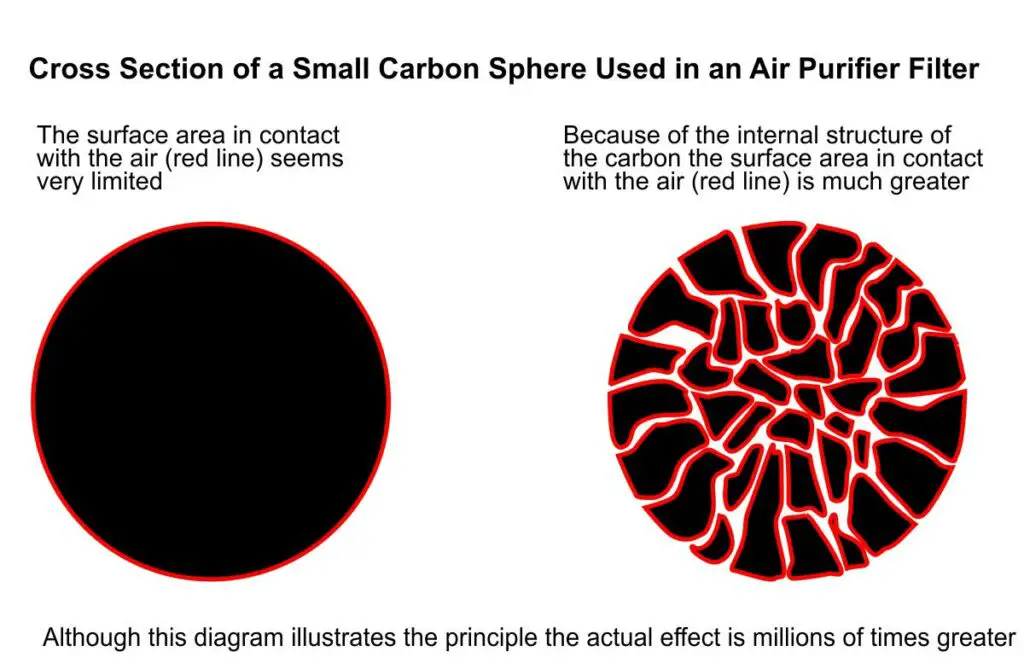
Activated charcoal has an enormous surface area 1 gram having a surface area of 32,000 square feet (3000m2). For instance, although the filter in the illustration below is only approximately 1 sq ft, it has an equivalent surface area for absorbing gas of 80 million sq ft!
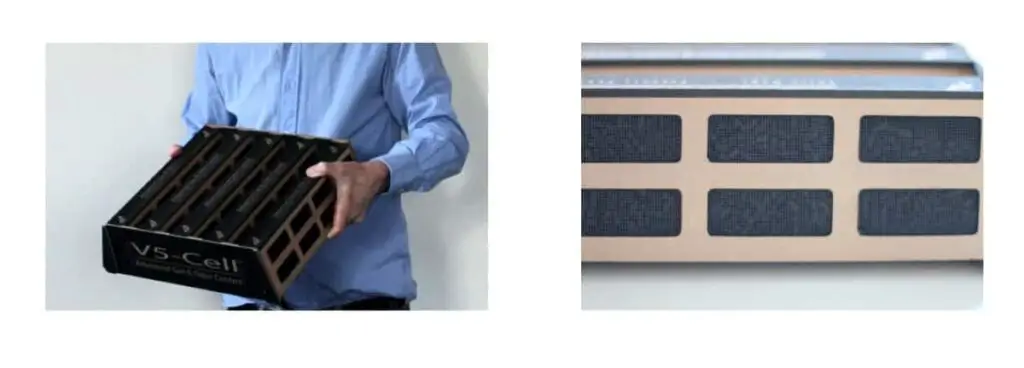
Activated carbon filters are not good at removing chemicals called aldehydes, of which formaldehyde and acetaldehyde are the most well-known examples. Formaldehyde is widely used in the manufacture of furniture and so enters our homes when we buy new furniture.
Activated carbon does not reduce radon. So air purifiers are not effective at reducing radon, sealing the basement and ventilation systems are key.
Solutions to Problems With Carbon Filters
Other materials can be added to the activated carbon increase its absorption of some compounds –
Add Activated Alumina Impregnated With Potassium Permanganate (eg iQair air purifiers) to the Carbon Filter
Activated alumina is very porous and has a surface area significantly greater than 200 m² per gram! Because of this very large surface area, it is ideally suited to the processing of gases in an air purifier. The table below shows the percentage of its own weight in gases that it removes–
| Contaminant/VOC | Percentage of Activated Alumina Mass of Gas Removed |
|---|---|
| Nitrogen Dioxide | 11% |
| Hydrogen Sulphide | 8% |
| Sulfur Dioxide | 4% |
| Nitric Oxide | 3% |
| Formaldehyde | 1% |
For instance, this means that 100g of activated alumina impregnated with potassium permanganate would remove 11g of nitrogen dioxide.
This media removes contaminants by destruction by oxidation, chemisorption where the contaminant reacts with the surface and becomes bound to it and by adsorption where weak intermolecular forces trap the contaminant or the product of its reaction with the potassium permanganate.
By oxidising chemicals, it improves the removal of formaldehyde, acetaldehyde and dichloromethane. So this is aimed at lower molecular aldehydes (e.g. formaldehyde) and organic acids (e.g. acrylic acid, acetic acid), sulfuric oxides (e.g. sulfur dioxide, sulfur trioxide) and nitrogen oxides (nitrogen monoxide, nitrogen dioxide). This is in distinction to pure activated carbon which is better for higher molecular weight compounds. So when the 2 components, carbon and alumina or zeolite are combined into one filter, it is sometimes referred to as a “Multigas” filter as shown in this diagram-
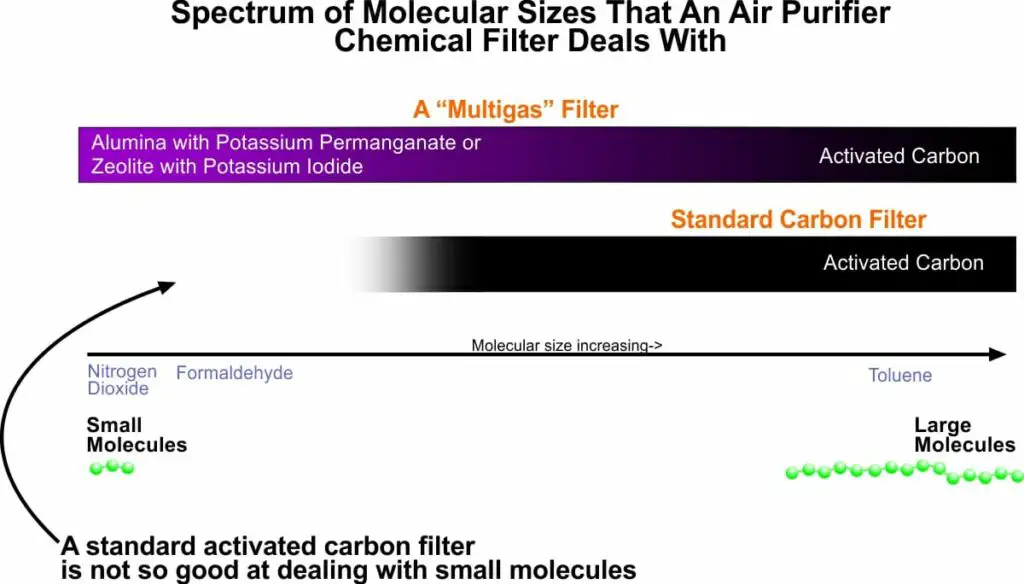
Add Zeolite Impregnated With Potassium Iodide (eg Austin Air air purifiers) to the Carbon Filter
Zeolites are microporous (so act like sponges) compounds made of aluminium and silicate. They have a uniform pore size up to 3 nanometers and so cannot trap molecules larger than this. So zeolite is usually combined with activated carbon if used in an air purifier filter as, the activated carbon can deal with the larger molecules.
The absorption of VOCs, ie dependent on the type of zeolite, silica/aluminium ratio, crystallinity, binder type and content. Water content of the air can compete with and decrease the adsorption of some VOCs, although not so much for other chemicals eg nitrogen oxides. Sodium and copper Faujasite zeolites can adsorb small molecules such as formaldehyde. Although natural zeolites attract water, artificial zeolites can be made to repel water or be neutral in their interaction with water.
Silica (SiO2) does not adsorb nitric oxide or nitrogen dioxide, so the absorption capacity of the zeolite for these is a function of its structure, ie are their enough pores/space in the zeolite for the contaminants to be trapped, like a sponge.
Potassium iodide-helps oxidise formaldehyde and other VOCS so removing them from the air but potentially making other chemicals as byproducts.
At the following link, you can find further information on the best air purifier for Formaldehyde.
Activated Carbon Filters Performance Can Decline Steeply With Time
One study showed that the performance of the VOC removal in an initially best-performing air purifier that they tested fell steeply with time. After only 15% of the predicted lifetime of the filter performance fell by 50%. This probably depends on the quality of the activated carbon in the filter and emphasizes the need to buy the air purifier from a very reliable professional manufacturer.
Overall Best VOC Air Purifier (Serves 200 sq ft* per machine)
iQair Multigas (supreme chemical filter specification and supreme particle filter)
The air coming out of this air purifier will be better than any other air purifier on the market. It is specified to remove 99.5% of particles greater than 0.003um, the best particle specification on the market. Its removal of chemical compounds may well be the best on the market as well, there is only one other air purifier that comes close.
No pre-filter cleaning needed, this is quite an advantage as almost all other air purifiers have a type of pre-filter which should theoretically be cleaned every 2-4 weeks.
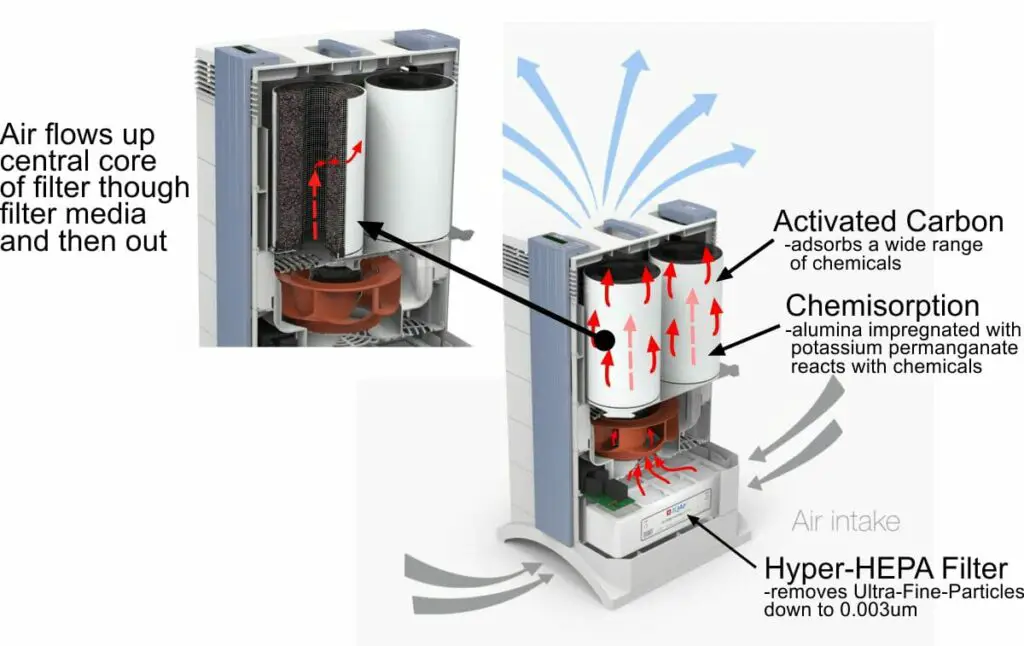
| Filters | |
| HEPA filter | HEPA specified to remove 99.8% of ultrafine particles down to a size of 0.003um |
| Carbon filter amount of carbon (lb) | 12 lb so so 100x more than some other air purifiers |
| Filter Change HEPA (Particles) | 12 months |
| Filter Change Carbon (Chemicals) | 29 months |
| Airflow | |
| CADR at =<50db (CADR on Maximum) | 170 cfm |
| Maximum Room Size (Noise less than 50db*) | 262 sq ft |
| Maximum Room Size (On noisiest setting) | 462 sq ft |
| Smart Control | Yes smart plug |
| Power | 74 W |
| Weight | 44 lbs |
| Dimensions “H x “W x D” | 28x 15 x 16 |
| Annual Running Cost Electricity ($) | $45 |
| Annual Running Cost Filters ($) | $285 |
| Total Annual Running Cost ($) | $330 |
All the above are approximate and assume running the air purifier for 12 hours per day on the highest setting that keeps the noise below the level specified in db in the table. This is less than or equal to 50db in normal daytime use and 35db for bedrooms.
*Most people will not wish to have the air purifier on a setting louder than about 35db for sleeping in a bedroom-you may wish to have a quieter setting than 35db this is just a ballpark estimate for most people. On the other hand, if your room layout allows you to be much further than 6 feet from the air purifier you may find the noise this machine makes at top speed is alright. The calculations for room size assume that you have 8 foot ceilings and 5 air changes per hour.
Never run an air purifier on auto mode using the inbuilt sensor. These cannot detect ultrafine particles which are damaging to human health, please see this article- How to test the air quality in your home.
Second Best VOC Air Purifier (Serves 262 sq ft* per machine)
iQair HealthPro Plus (second best chemical filter specification and supreme particle filter)
This air purifier is more affordable than the iQair Multigas and has a better carbon filter than the Coway 400s. It is only suitable for rooms up to 262 sq ft, assuming the room has 8ft ceilings unless you are very tolerant of noise.
No pre-filter cleaning needed, this is quite an advantage as most air purifiers have pre-filters which should theoretically be cleaned every 2-4 weeks!
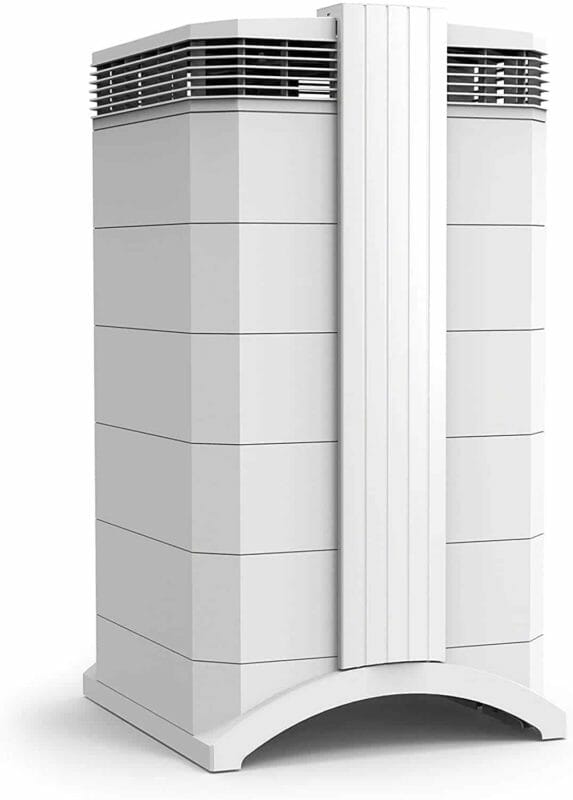
Advantages
| Filters | |
| HEPA filter | HEPA specified to remove 99.8% of ultrafine particles down to a size of 0.003um |
| Carbon filter amount of carbon (lb) | 5 lb so 40x more than some other air purifiers |
| Filter Change HEPA (Particles) | 15 months for pre filter 48 months for Hyper-HEPA filter |
| Filter Change Carbon (Chemicals) | 20 months |
| Airflow | |
| CADR at =<50db (CADR on Maximum) | 170 cfm |
| Maximum Room Size (Noise less than 50db*) | 262 sq ft |
| Maximum Room Size (On noisiest setting) | 462 sq ft |
| Smart Control | Yes smart plug |
| Power | 74 W |
| Weight | 35 lbs |
| Dimensions “H x “W x D” | 28x 15 x 16 |
| Annual Running Cost Electricity ($) | $45 |
| Annual Running Cost Filters ($) | $180 |
| Total Annual Running Cost ($) | $230 |
There is a more extensive review of this air purifier here.
Most Air Purifiers Themselves Initially Emit VOCs
Most air purifiers emit VOCs from the plastic used in their construction. This “off-gassing” will gradually reduce in time as the VOCs in the plastic will all have been released into the air. There is only one manufacture that I know of that specifically states that they use plastic of such high quality that this is not a problem – iQair. An alternative approach is taken by Austin Air, which use powder coated steel to avoid the emission of VOCs.
Difficult for You to Check the Performance of the Chemical Removal of the Chemical Filter
Amongst all the potential problems with the removal of VOCs by air purifiers, there is the additional problem of how to measure the performance of the air purifier. Unfortunately, the measurement of VOCs is not straightforward. Many of the chemicals require individual methods of measurement which do not apply to other VOCs. No single method can measure all VOCs. One VOC may have several potential methods of measuring it, each with its own advantages and disadvantages. So even if a VOC level is given, the person interpreting the level needs to know what method was used to measure it.
There are consumer level meters that will measure formaldehyde and “TVOC”-total VOC. These are realistically all the consumer can use to get an idea of chemical pollution in their home. A practical example of a meter is outlined towards the bottom of this article “VOCs and health“.
VOC Removal-Never Forget Ventilation
The concentration of volatile organic compounds in the external air is usually minimal compared to the indoor air. So one of the most effective ways of reducing VOCs in the indoor air is simply to ventilate the home well. As we are moving to more efficient insulation of our homes for energy efficiency, we have to be careful to allow for adequate ventilation.
Rather than simply ventilating every so often, fairly continuous ventilation can be done by air exchange. There exchange units often incorporate heat exchange elements. In these the air leaving the home goes through a radiator like device and the air entering the home flows over the radiator and so before it enters the home its temperature becomes more to that of the home air.
Of course there are areas of the US and other industrialized countries where the concentration of VOCs in the external air means that at times ventilation is not a good idea. An example would be “chemical alley” in the US.
Conclusion
When improving indoor air quality by using an air cleaner to reduce airborne particles we should also aim to reduce airborne chemicals, particularly VOC concentration. Unfortunately, air purifiers with activated carbon filters are very variable in their ability to remove VOCs. This stems from the physical design of the carbon filter, the quality of the carbon in the filter and any additional compounds added to the activated carbon to make it more effective.
The best VOC air purifier is the iQair Multigas, fitted with multigas filters rather than the alternative filters. This together with the iQair HealthPro Plus are really ahead of the field on the combination of chemical and particle removal. There simply are not any comparable air purifiers whose manufacturer gives complete data.
Photoelectrocatalytic (PECO) air purifiers have been shown by Wirecutter not to reduce particle count well, however they may have a role in dealing with VOCs. So an ideal combination may be to have a HEPA air purifier to deal with airborne particles and a carbon filter with alumina impregnated with potassium permanganate to deal with chemicals, and use it together with a PECO air purifier to deal with chemicals not caught by the carbon/alumina filter.
This would be expensive, and activated carbon filters do remove VOCs, albeit more slowly, provided you buy the right air purifier of course. The difficulty is that manufacturers of standard HEPA air purifiers hardly give any real world quantitative data regarding the removal of VOCs, and AHAM does not do any testing of VOC removal. So it is impossible to know which air cleaners are effective.
So for VOC removal, it would seem wise to stick to one of the iQair air purifiers with a carbon/alumina filter and the best of these for VOC removal would be the iQair Multigas.
However, before we get too carried away with chemical removal, we should remember that fine and ultrafine particles are usually a bigger potential threat to human health and so any air cleaner should not compromise on particle removal.
Related Questions
Related Posts
Best air purifier for cat litter



